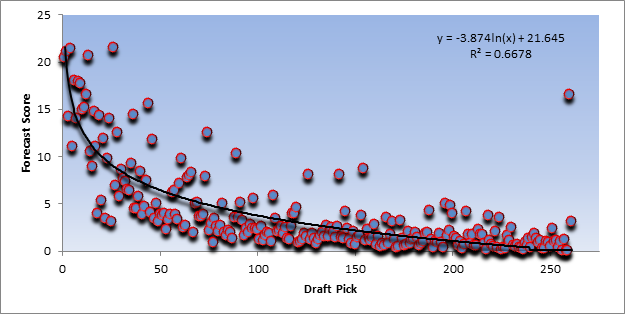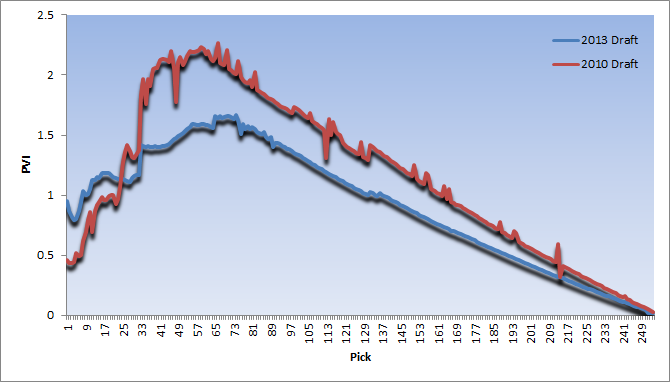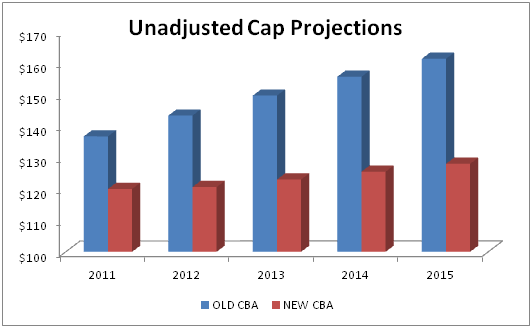[adsenseyu1]
One of the big concessions made by the union in the last CBA dealt with the institution of a true rookie wage scale for all draft picks. Salaries at the top of the NFL draft had more or less grown out of control with Sam Bradford, the final number 1 overall pick in the old system, signing a $78 million dollar contract without ever stepping foot onto a NFL football field. Even today Bradford’s deal holds as the 10th largest contract at the position when measured by annual value and Bradford is a bottom tier QB. Due to the salary cap consequences of releasing him Bradford is essentially protected from being released.
While NFL teams certainly have the money to afford these deals on a cash basis, on a cap basis they had become prohibitive to the point where high draft picks were being devalued due to the high risk and excessive cost associated with the draft picks. So I wanted to look into the ways by which we can value a draft pick and examine the cost/performance relationship of a player’s career and his draft status.
The Methodology
Last year I began working on a draft valuation using data from pro football reference to score players based on Pro Bowls, Years as a Starter, and Games Played. The player’s individual score was compared to the average for his particular draft class and a score was awarded in each category and summed to calculate a total score. As my buddy RJF, a great poster over on Jetnation.com, pointed out that the use of a Pro Bowl can skew the numbers because the PB becomes a fan lovefest rather than an actual measure of productivity. While I disagree to some extent as those initial Pro Bowls require strong play to get elected for the most part (players like Mike Vick notwithstanding) at the end of a career those votes are solely based on reputation. To try to limit that this time I included All Pro nods as those are a much more difficult award to obtain. While favoritism comes into play it’s not to the extent of the Pro Bowl.
In my mind games played is a measure of being simply good enough to put a helmet on and play. In this case a special teams player is given just as much credit as Peyton Manning for simply suiting up. Getting games out of your draft picks is certainly important. Starting seasons separates those depth players from those top players on a team. If every player in your draft class turns into a starter you either did a terrific job or your team is really bad and has a lot of holes to fill. The Pro Bowl and All Pro nods measure the quality of the play itself. It’s one thing to be a starter, but it’s another to be a great starter, one of the best in the NFL. Obviously perennial all world players will get major scores for this.
I also did not compare to each individual draft class this time around as it was skewing the results when trying to pass an “eye test”. For example Ed Reed under that format was the best draft pick of the sample period because he was dominant in what was a poor draft class. Reed is a great player but his numbers just don’t match others and it seemed unfair for him to be rated so high. Instead I took the average performance from 1993, which was when the cap began and the drafts shrunk in size, to 2006. The average draft pick over that timeframe has a career of 63.3 games played, 2.3 starting seasons, 0.33 Pro Bowls, and 0.09 All Pro nods. Obviously some of these players are still playing and the numbers will change slightly over time with good players from 05 and 06 being a bit understated but for the sake of this study I felt it was reasonable enough to include them. Punters and kickers, who are given starting credit, are also overstated and should just be looked at as outliers.
To illustrate how this works I’ll use Ray Lewis who graded out as the top draft pick of the time period. Lewis finished his career with 228 games, 14 starting seasons, 13 Pro Bowls, and 7 All Pros. Those numbers would make him 2.6, 4.97, 38.3, and 77.1 times as productive in each category as the average draft pick. His total score would be 123 which I adjusted up by 4 to bring everyone up to a minimum of 0 giving him a 127 composite score. The top 5 players were Lewis, Tony Gonzalez, Peyton Manning, Larry Allen, and Alan Faneca. Manning and Gonzalez will likely jump Lewis. About 12.3% of all draft picks never played a game in the NFL.
Every players score was calculated and the draft slot score then averaged. Overall the 4th pick in the draft actually produced the most quality points. Just using a basic Excel regression we can get the best fit line and get the following to get our approximate values:

Financial Situations
So keeping this in mind we can now come up with an expected player performance for our draft pick ranging from 21.936 for the first pick down to nothing for our final draft selections. Our rookie money we are spending is a blind investment for the expected return. Obviously that cost is significantly reduced from the prior CBA draft. What I want to do is create a performance vs investment ratio (PVI) that measure the amount of expected performance above the average draft pick divided by the rookie contract cost of the slot compared to the average contract. A ratio below 1 indicates an overpriced pick and above 1 an underpriced pick. To compare with the old CBA I am using the 2010 APY’s for the players. This is not a perfect list since certain players hit rookie escalators and some did not but for the sake of comparison should be reasonable. Where you see some strange spikes it likely means the pick was a QB or I had insufficient data.

The change in the salary structure, specifically at the top of the draft, in the new CBA had significant changes on the true value of the first round, and in particular the top 10, draft picks. Under the old system the number 1 pick was incredibly overpriced compared to the rest of the draft. You paid 12.3 times the amount of the average player for Sam Bradford but were only expected to gain 5.6 times the performance over an average player. At that salary the only players to give you 12.3 times the average performance or greater out of the 1 slot were Peyton Manning and Orlando Pace, in essence a 14% chance at making it worthwhile. Even taking the first three picks into account only 5 out of 42 selections (the other 3 being Julius Peppers, Marshall Faulk, and Tony Boselli all 2nd overall picks) hit the number. Under the new system the pay vs expected performance is almost equal. The pick is still a touch overpriced but now it’s more reasonable of an expectation. 10 players of the first 42 selected have hit that threshold and a number of others are close.
In both cases your best bang for the buck comes in round 2 and the earliest stages of round 3. Based on salary being paid the most value is actually right at the top of round 3. That doesn’t mean a team should load up with players there it just means there is the least risk associated with the salary outlay and expected performance. Under the new CBA you can make a strong case to draft in the 8 slot and have a strong chance of justifying the investment. In the old CBA it would have been number 20 where the cost started to match the production.
Prices begin to get overvalued again around the 140th pick in the draft. Some of that risk is balanced out by the fact that these draft picks contain minimal guaranteed money unlike the 1st and 2nd round selections, but in general the contract being signed is probably not worth the cost. Other than just throwing something against the wall to see if it sticks the 5th rounders and beyond are almost worthless commodities and stockpiling those picks is most likely not going to pay off.
High End Risk Minimization
Now of course you are paying a premium in all of these picks that I say are overvalued because of your expectation of greatness. Nobody goes into a draft and says “boy that guy we just drafted is going to be average”. In almost all cases you think you hit a home run. While everyone has their own measuring stick for a great pick I think many will look at being a multi time Pro Bowler or All Pro as a sign of greatness. As a guide here are the percentages of multi time Pro Bowlers and All Pros based on where they were selected. Please note that Round 1 means picks after 11.
| Slot | Multi-Pro Bowl | Multi All- Pro | Avg.PVI | Avg Salary 2013 | Avg Salary 2010 |
|---|
| Top 5 | 48.6% | 12.9% | 0.84 | $5,120,601 | $10,816,667 |
| 6-10 | 30.0% | 11.4% | 0.97 | $3,423,740 | $6,234,580 |
| Round 1 | 25.9% | 6.1% | 1.08 | $2,097,071 | $2,629,548 |
| Round 2 | 10.3% | 3.0% | 2.09 | $1,079,548 | $863,995 |
| Round 3 | 5.5% | 1.5% | 1.92 | $713,643 | $640,232 |
| Round 4 | 3.1% | 0.6% | 1.52 | $651,490 | $566,732 |
| Round 5 | 2.7% | 0.6% | 1.19 | $594,944 | $494,989 |
| Round 6 | 2.5% | 0.6% | 0.77 | $571,117 | $473,925 |
| Round 7 | 0.8% | 0.2% | 0.38 | $558,716 | $464,188 |
Looking at these percentages plus the PVI I would say that most teams are better off moving out of the top 5 or out of the top 10 entirely. In my opinion the real sweet spot to balance that risk and reward is in the 2nd round. It is great value for the price and you are still getting a decent probability of a Pro Bowl caliber player. The way the NFL slots salaries is not really commensurate with the drop in play. There is virtually no difference between the expected performance of the 32nd and 33rd pick yet the APY drops by about 20%. Between the 2nd and 3rd round the drop is a more reasonable 6.9%. It’s all about that status the NFL gives for being a 1st round pick and it is far too high of a price.
That being said if our goal is to hit a home run (and whose goal isn’t) teams are still far better off drafting in the meat of the 1st round. I base this on the ratio of pro bowls vs cost. Drafting in the top 5 only makes us 1.9 times more likely to find a multi time Pro Bowler and 2.1 times as likely to get the multi time All Pro yet we pay, on average, around 2.5 times as much for the selection . Here is how round 1 compares to every slot in the draft:
| Increased Multi Pro Bowl | Increased Cost | Ratio |
|---|
| Top 5 | 0.53 | 0.41 | 1.30 |
| Top 10 | 0.86 | 0.61 | 1.41 |
| Round 1 | 1.00 | 1.00 | 1.00 |
| Round 2 | 2.51 | 1.94 | 1.29 |
| Round 3 | 4.71 | 2.94 | 1.60 |
| Round 4 | 8.35 | 3.22 | 2.60 |
| Round 5 | 9.59 | 3.52 | 2.72 |
| Round 6 | 10.36 | 3.67 | 2.82 |
| Round 7 | 32.38 | 3.75 | 8.63 |
In every situation our ratio is above 1. This means we are paying far less for the reasonable chance of landing the multi time Pro Bowler. If you can trade out of the top 5 and pick up a mid round pick plus a second round pick you are going to have a far better chance of being successful and not screwing up your salary cap than if you remain in the top 5. Under such a scenario you are 0.75 times as likely as landing the great player but you pay 0.52 times the cost, factoring in the fact that the 2nd draft pick eliminates a minimum salaried contract. That improves our ratio from a 1.3 to 1.4. Throw in a 4th rounder and we improve to a 1.46. This is all in contrast to the old CBA where no first round pick justified the risk at all. The 2nd round was the rea where you had to move which is going to minimize the chance of hitting on the player.
Now there are plenty of teams who follow a draft philosophy of more is better and will constantly move around to maximize picks. Moving around, IMO, for 6th and 7th rounders is probably not worth the effort. Clearly there is almost no value to the 7th round pick. There is a distinct drop in high end quality between the 6th and 7th and as it stands the minimum salaries and small bonuses are not going to produce results that justify the salary. The 6th round is a little more reasonable as the PB chances are more or less the same as a 4th and 5th rounder but the overall cost to gain that benefit is probably not worth it. Stockpilers need to focus on rounds 3-5 to make the most effective use of their dollars. Trading down to gain 6th and 7th rounders is not going to pay off.
Going back to the 2006 CBA clearly the NFL was way off in their pay slotting. While it is better now there is still too high of a premium going to the top of the first round. While it would never happen (except internally with teams) the salary structures should be used to either upgrade or downgrade point totals on the draft charts teams use. Bu teams are so in love with the chance of the number 1 pick and landing the next Peyton manning that most logical thinking goes out the window when they hand in the card and happily select David Carr or JaMarcus Russell. While failures to that level are not likely the odds were against the Texans and Raiders of ever finding a player worth the price tag.
While I did not touch on this here there is also something to be said for positional drafting. There are certain positions that have proven to be winners and losers in each round of the draft. Considering the commitments teams are making in guaranteed money in the first two rounds of the draft if there is even a hint of a disagreement between two players teams should consider looking at the historical positional trends to further minimize the salary risk of the draft pick. Maybe we’ll touch on that in the future one day, but I think this is a nice little start with merging the salary cap and the draft.
If anyone is interested in the pick by pick PVIs, salaries, expected results, etc… just drop me a line and I can try to get you a spreadsheet or just post a table on the site. It might take me a few days to get it out but I’ll do my best to get it out. I’d also like to extend a special thanks to our contributor Ian Whetstone who had the 2010 rookie salary data in a far more useful format than I had. I only had to make some small changes to the top picks from that year to get a relatively accurate picture of the 2010 salaries
[adsenseyu2]
[adsenseyu4]


